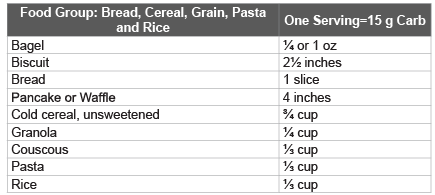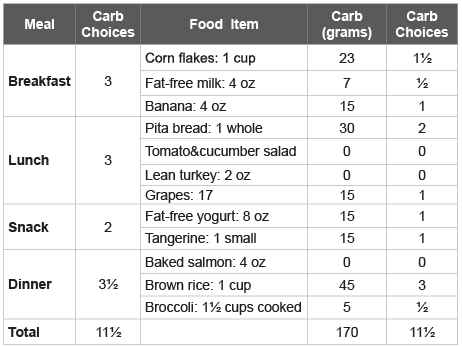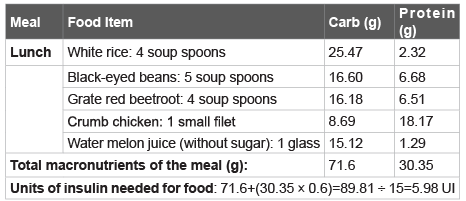
Table 1: Exchange List-Food serving containing 15 grams of carbohydrate [13].

Helena Dória Ribeiro de Andrade Previato*
Department of Food and Nutrition, School of Food Engineering, University of Campinas, Campinas, Brazil*Corresponding author: Helena Dória Ribeiro de Andrade Previato, Department of Food and Nutrition, School of Food Engineering, University of Campinas (UNICAMP), 80 Monteiro Lobato St. Zip Code: 13.083-862, Campinas/SP, Brazil, E-mail: helenapreviato@hotmail.com
Carbohydrate counting is a method of calculating grams of carbohydrate consumed at meals and snacks. It was created to provide a healthy and varied food planning for patients with diabetes. The method consists in calculate the grams of carb per meal in order to maintain an adequate level of blood glucose and decrease variations of postprandial glycemic response. The technique prioritizes the amount of carb intake.
This review aims to present and detail the carbohydrate counting method in the dietary treatment of patients with type I and type II diabetes, identifying the applicability and nutritional advantages of the technique.
A literature review was conducted without restriction date and only with indexed primary sources in SciELO databases, PubMed, Medline, Lilacs, Dedalus and ISI Web of Knowledge.
The review research found two methods of carbohydrate counting: basic (exchange system) and advanced (method by grams). Both methods have advantages and disadvantages and should be adopted in accordance with routine and patient lifestyle. The exchange system is more simple to use, but is less accurate. The advanced tool is more precise, however is more laborious. So, the choice of the best method should be appropriate to each patient. Finally, carbohydrate counting is an important tool that allows a better adherence to dietary management and intake of a greater variety of foods. This nutritional strategy also helps to maintain an adequate level of blood glucose and reduce variations in postprandial glycemic response.
Since diabetes is a chronic disease, adopt a more flexible and varied diet using basic or advanced carbohydrate counting will allow a greater adherence to nutritional therapy and better quality of life for patients with diabetes.
Carbohydrate counting; Diet; Food planning; Nutrition; Diabetes
ADA: American Diabetes Association; Carb: Carbohydrate; DM: Diabetes Mellitus; g: grams; IDF: International Diabetes Federation; TEE: Total Energy Expenditure; T1D: Type I Diabetes; T2D: Type II Diabetes; UI: Units of Insulin.
Diabetes mellitus (DM) is a metabolic disorder characterized by high blood glucose level resulting in failure of pancreas to produce and/or secrete insulin [1]. DM is one of the largest worldwide health emergencies of the 21st century. The prevalence of the disease increases every year. According to the International Diabetes Federation (IDF), 415 million adults have diabetes and by 2040 this will rise to 642 million [2].
There are two main types of diabetes: type I and type II. Type I diabetes (T1D) is less common, but it is still increasing by around 3% every year, particularly among children [2]. In T1D, the body does not produce insulin [1]. Type II diabetes (T2D) is the most prevalent form of the disease and it has increased around the world [2]. In this case, the body does not use insulin properly (insulin resistance). Excess body weight, physical inactivity, older age and poor nutrition are risk factors for T2D [2]. So, eating habits characterized by increased intake of highcalorie and high-fat foods, sugars and low fiber intake may contribute to development of T2D.
Proper nutrition provides metabolic control of diabetes. However, patient’s adherence to dietary treatment is a major challenge [3]. Carbohydrate counting is an alternative for nutritional management of diabetes. The technique is an established approach used by patients to improve their glycemic control, since they can be taught how to evaluate the carb content of the meal in grams or in food choices [4].
This nutritional strategy allows a better adherence to dietary management and consumption of a greater variety of foods [5]. It helps patients to choose their food in a meal planning by controlling carb intake, which may contribute for better glycemic control and maintenance of adequate levels of glucose blood [6]. Therefore, this study aimed to present the carbohydrate counting method in dietary treatment of patients with diabetes.
Carb counting was created in Europe in 1935 to provide a healthy and varied food planning for patients with diabetes. The method began to be recommended worldwide by American Diabetes Association (ADA) in 1995 [7]. The technique arouses interest in health professionals by offering greater flexibility in dietary management, in addition to encouraging autonomy of patients with diabetes [8]. Carb counting consists in calculate the grams of carb per meal in order to maintain an adequate level of blood glucose and decrease variations of postprandial glycemic response. The technique prioritizes the amount of carb intake, whereas 100% of carb are converted into glucose in a period of time that varies from 15 minutes to 2 hours [9].
The method can be used by patients with type I or type II diabetes. It is probably the most precise and flexible meal planning approach available. Once the patient knows how many grams of carb they need at each meal, they will be able to choose foods from any of the food groups that contain carb. This method of meal planning offers variety in food choices [10]. Carb counting along with the glycemic monitoring, drug therapy and physical exercise improve glycemic and metabolic profile, decrease the occurrence of chronic complications and thus provide better quality of life for patients with diabetes [9,11].
There are two methods of carb counting: Basic carb counting (exchange system) and Advanced carb counting (method by grams). Both methods have advantages and disadvantages and should be adopted in accordance with routine and patient lifestyle [9]. The exchange system is more simple to use, but is less accurate. The advanced tool is more precise, however is more laborious. So, the choice of the best method should be appropriate to each patient and depending on the case, both methods can be used at the same time [12].
In this method know as exchange system, foods are divided into groups and each serving size is equal to 15 g of carb, which is considered 1 carb choice. Thus, it is permitted to vary the diet plan, making changes in the same food group (replacing bread for biscuits, for example). Or it is possible to make changes between groups (substituting a food from milk group for a food from fruit group, for example). This can be done since the foods show the same amount in grams of carb (15 g) [3].
Therefore, it is important to read food labels and exchange lists for the exact carb amount in a food item. Exchange lists can be provided by health professionals to help calculating the carb amount in foods [13]. Table 1 shows some common serving sizes containing 15 grams of carb.
Exchange list can be used to vary the food, allowing greater diversity in food planning and a better adherence to diet [13]. In order to facilitate the calculations, it is permitted to approach values up or down. It is estimated that 1 portion of food group is equal to 15 g of carb. In addition, variations from 8 to 22 g of carb are also regarded as 1 choice of carb (15 g of carb) [12].
Exchange system is more appropriate to T2D patients since they do not use insulin injection. So, they should consume the same quantities of carb established in the meal planning according basic carb counting method [7,12]. For patients with T1D, who necessary use insulin therapy, is recommended the advanced carb counting [12].
In general, the food plan for patient with diabetes should be composed of: 50-60% of total energy expenditure (TEE) of carb; 15-20% of protein (1 g of protein/kg of body weight); and 25-35% of fat [12,14]. Example: TEE=2000 kcal/day; 50% of carb=250 g (1000 kcal ÷ 4); 20% of protein=100 g (400 kcal ÷ 4); 30% of fat=66.6 g (600 kcal ÷ 9). Considering that carb and protein generate 4 kcal/g and fat generates 9 kcal/g. After that, it is necessary to follow certain steps to use the exchange method: Step 1) calculating the dietary carb; Step 2) calculating carb amount per meal; Step 3) distribute serving of carb among meals; Step 4) offer a list of foods and their equivalents in carb (exchange list) [12].
Here is portrayed a case where the basic carb counting was used as a nutritional therapy for the patient with diabetes. Lia is a 35-year-old woman with T2D. Lia’s dietitian determined that she needs 172 grams of carb each day. How many carb choices is Lia allowed each day? Step 1) Carb are measured in grams; Step 2) 15 grams of carb=1carb choice; Step 3) Total carb (grams) per day ÷ 15 grams of carb=number of carb choices per day=172 grams ÷ 15 grams=11 ½ carb choices per day [15]. A sample meal plan is shown in table 2.

Table 1: Exchange List-Food serving containing 15 grams of carbohydrate [13].

Table 2: Sample meal plan based on Basic Carb Counting Method [15].
The total carb amount is accounted by the sum in grams of carb in foods and meals. This nutritional information is obtained in tables and food labels that show how much carb exists in a portion of food [12,16]. These steps are the same of the basic carb counting method. The difference is that the advanced method requires pre and post-prandial blood glucose monitoring, knowledge of insulin sensitivity factor and meal bolus [9].
The main advantage of method is the possibility of calculating dose of insulin (fast or ultrafast) to be administered according to carb amount in meal [9,13].
T1D patients need an insulin regime that is adjusted based on amount of carb consumed daily and lifestyle [17]. Thus, dietary planning based on carb counting and insulin regimes may provide more flexibility in dealing with mealtimes, appetite variability and exercise practice [17,18].
For these reason, the advanced carb counting (a method for insulin bolus calculation) is recommended in the management of T1D, since it offers more precise information about amount of carb in meal and insulin dosage [19].
The method allows adjustment of prandial insulin dose for carb intake. Carbs are the primary nutrients affecting postprandial glycemic response. Thus, by calculating carb amount in each meal, the insulin doses required to preserve an adequate postprandial blood glucose can be predicted [5,20,21].
Advanced carb counting allows estimating how much fast-acting (mealtime) insulin the patient will need [16]. In this case, to proceed properly it is necessary understanding some terms as: Basal Rate and Bolus Rate. Basal Rate is the insulin dose to correct blood glucose. It depends on the patient’s insulin sensitivity. Bolus Rate is the insulin dose to cover the grams of carb in the meal. It is calculated according to insulin-to-carb ratio [7,12]. The insulin-to-carb ratio is determined by dividing 500 by daily dose of insulin. Example: If a patient uses 34 units of insulin (UI) per day, the calculation is: 500 ÷ 34=14.7=15 grams. The insulin-to-carb ratio is 1: 15 (1 unit of insulin is needed to metabolize 15 grams of carb) [6].
The insulin-to-carb ratio varies between individuals and it is needed to be calculated individually as shown in the previous example. However, it is estimate1 unit of insulin to metabolize 15 g of carb in adults and between 20 to 30 g of carb in children [12,16]. Table 3 shows how to calculate insulin dose to cover the grams of carb in a sample meal plan using advanced carb counting.

Table 3: Sample meal using Advanced Carb Counting [12].

Table 4: Sample meal using Carb Counting [12].
In this therapy, carb counting is absolutely necessary. The insulin pump releases 24 hours basal insulin simulating pancreas secretion. During the meal, patient needs to adjust the pump to secrete bolus rate necessary to cover the grams of carb intake [3,12].
Fibers decrease the absorption of carb. So, when consume food rich in fiber (more than 5 g), it must be necessary to subtract the amount of fiber (in grams) of the total carb. Example: 100 g of cooked black beans contains 14 of carb and 8.4 g of fiber. Thus, the amount of carb available to be converted into glucose is: 14 g of carb - 8.4 g of fiber=5.6 g of carb [7,9,12].
Although protein is not the focus of carb counting, it must be included in the method since 35 to 60% of protein is converted into glucose [12,16]. Example: 180 g of meat contains 50 g of protein; 50 × 0.6 (60% of the amount of protein converted to glucose) will be equal to 30 g of carb [12]. Table 4 shows a sample meal using conversion of protein in carb.
Although carb counting is the most flexible meal planning for patients with diabetes, the tool has several limits. It is not applicable to all patients, which should be ability and willingness to carry the calculations of carb intake. Thereby, there are some limitations using the method in public hospitals or places where majority of patients is low socioeconomic status and literacy [6]. Besides, training in advanced carb counting is a complex intervention. Various interconnected components, including patientspecific and healthcare team may affect the outcome [19]. However, since diabetes is a chronic disease, a more flexible and varied diet using carb counting method will allow a better glycemic control in long-term. This justifies continued inclusion and improvement of recommendations about carb counting in clinical guidelines for the clinical management of diabetes.
Carb counting is an effective method that can be used by patients with diabetes to control the amount of carb intake. The main advantages of this technique are maintaining adequate blood glucose and giving more flexibility to the food planning. However, carb counting requires the patient’s ability to count the amount of carb in meals. So, it is important that health experts advise patients about the properly way to apply the method as a nutritional strategy to control blood glucose. Therefore, since diabetes is a chronic disease, adopt a more varied diet using carb counting will allow a greater adherence to the nutritional therapy and a better quality of life for patients with diabetes.
The author declares no potential conflicts of interest.
Download Provisional PDF Here
Article Type: Review Article
Citation: Dória Ribeiro de Andrade Previato H (2016) Carbohydrate Counting in Diabetes. Nutr Food Technol 2(2): doi http://dx.doi.org/10.16966/2470- 6086.124
Copyright: © 2016 Ribeiro de Andrade Previato HD. This is an open-access article distributed under the terms of the Creative Commons Attribution License, which permits unrestricted use, distribution, and reproduction in any medium, provided the original author and source are credited.
Publication history:
All Sci Forschen Journals are Open Access